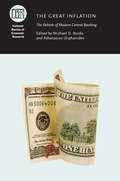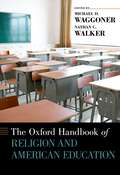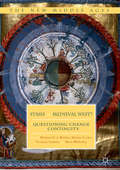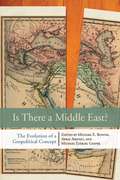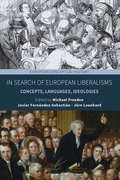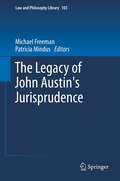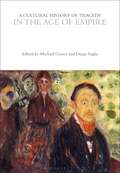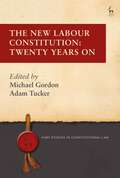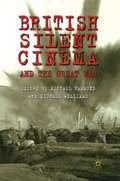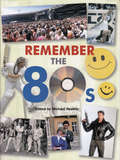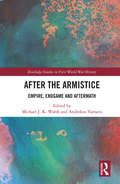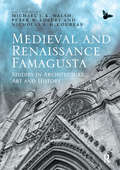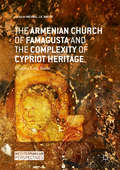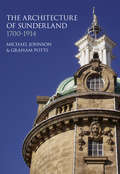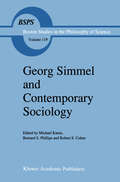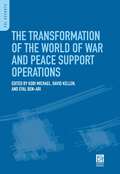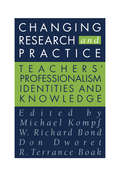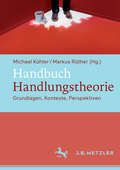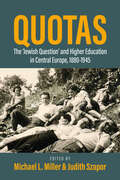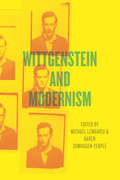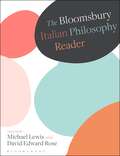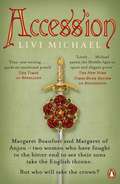- Table View
- List View
The Great Inflation: The Rebirth of Modern Central Banking (National Bureau of Economic Research Conference Report)
by Michael D. Bordo, Athanasios OrphanidesControlling inflation is among the most important objectives of economic policy. By maintaining price stability, policy makers are able to reduce uncertainty, improve price-monitoring mechanisms, and facilitate more efficient planning and allocation of resources, thereby raising productivity. This volume focuses on understanding the causes of the Great Inflation of the 1970s and ’80s, which saw rising inflation in many nations, and which propelled interest rates across the developing world into the double digits. In the decades since, the immediate cause of the period’s rise in inflation has been the subject of considerable debate. Among the areas of contention are the role of monetary policy in driving inflation and the implications this had both for policy design and for evaluating the performance of those who set the policy. Here, contributors map monetary policy from the 1960s to the present, shedding light on the ways in which the lessons of the Great Inflation were absorbed and applied to today’s global and increasingly complex economic environment.
The Oxford Handbook of Religion and American Education (Oxford Handbooks)
by Michael D. Waggoner, Nathan C. Walker and Martin E. MartyFrom the founding of Harvard College in 1636 as a mission for training young clergy to the landmark 1968 Supreme Court decision in Epperson v. Arkansas, which struck down the state's ban on teaching evolution in schools, religion and education in the United States have been inextricably linked. Still today new fights emerge over the rights and limitations of religion in the classroom. The Oxford Handbook of Religion and American Education brings together preeminent scholars from the fields of religion, education, law, and political science to craft a comprehensive survey and assessment of the study of religion and education in the United States. The essays in the first part develop six distinct conceptual lenses through which to view American education, including Privatism, Secularism, Pluralism, Religious Literacy, Religious Liberty, and Democracy. The following four parts expand on these concepts in a diverse range of educational frames: public schools, faith-based K-12 education, higher education, and lifespan faith development. Designed for a diverse and interdisciplinary audience, this addition to the Oxford Handbook series sets for itself a broad goal of understanding the place of religion and education in a modern democracy.
Stasis in the Medieval West?: Questioning Change and Continuity (The New Middle Ages)
by Michael D.J. Bintley Martin Locker Victoria Symons Mary WellesleyThis volume questions the extent to which Medieval studies has emphasized the period as one of change and development through reexamining aspects of the medieval world that remained static. The Medieval period is popularly thought of as a dark age, before the flowerings of the Renaissance ushered a return to the wisdom of the Classical era. However, the reality familiar to scholars and students of the Middle Ages – that this was a time of immense transition and transformation – is well known. This book approaches the theme of ‘stasis’ in broad terms, with chapters covering the full temporal range from Late Antiquity to the later Middle Ages. Contributors to this collection seek to establish what remained static, continuous or ongoing in the Medieval era, and how the period’s political and cultural upheavals generated stasis in the form of deadlock, nostalgia, and the preservation of ancient traditions.
Is There a Middle East?: The Evolution of a Geopolitical Concept
by Michael E. Bonine, Abbas Amanat & Michael Ezekiel GasperIs the idea of the "Middle East" simply a geopolitical construct conceived by the West to serve particular strategic and economic interests—or can we identify geographical, historical, cultural, and political patterns to indicate some sort of internal coherence to this label? While the term has achieved common usage, no one studying the region has yet addressed whether this conceptualization has real meaning—and then articulated what and where the Middle East is, or is not. This volume fills the void, offering a diverse set of voices—from political and cultural historians, to social scientists, geographers, and political economists—to debate the possible manifestations and meanings of the Middle East. At a time when geopolitical forces, social currents, and environmental concerns have brought attention to the region, this volume examines the very definition and geographic and cultural boundaries of the Middle East in an unprecedented way.
In Search of European Liberalisms: Concepts, Languages, Ideologies (European Conceptual History #6)
by Michael Freeden, Javier Fernández-Sebastián Jörn LeonhardSince the Enlightenment, liberalism as a concept has been foundational for European identity and politics, even as it has been increasingly interrogated and contested. This comprehensive study takes a fresh look at the diverse understandings and interpretations of the idea of liberalism in Europe, encompassing not just the familiar movements, doctrines, and political parties that fall under the heading of “liberal” but also the intertwined historical currents of thought behind them. Here we find not an abstract, universalized liberalism, but a complex and overlapping configuration of liberalisms tied to diverse linguistic, temporal, and political contexts.
The Legacy of John Austin's Jurisprudence (Law and Philosophy Library #103)
by Michael Freeman and Patricia MindusThis is the first ever collected volume on John Austin, whose role in the founding of analytical jurisprudence is unquestionable. After 150 years, time has come to assess his legacy. The book fills a void in existing literature, by letting top scholars with diverse outlooks flesh out and discuss Austin’s legacy today. A nuanced, vibrant, and richly diverse picture of both his legal and ethical theories emerges, making a case for a renewal of interest in his work. The book applies multiple perspectives, reflecting Austin’s various interests – stretching from moral theory to theory of law and state, from Roman Law to Constitutional Law – and it offers a comparative outlook on Austin and his legacy in the light of the contemporary debate and major movements within legal theory. It sheds new light on some central issues of practical reasoning: the relation between law and morals, the nature of legal systems, the function of effectiveness, the value-free character of legal theory, the connection between normative and factual inquiries in the law, the role of power, the character of obedience and the notion of duty.
A Cultural History of Tragedy in the Age of Empire (The Cultural Histories Series)
by Michael Gamer and Diego SagliaThis volume traces a path across the metamorphoses of tragedy and the tragic in Western cultures during the bourgeois age of nations, revolutions, and empires, roughly delimited by the French Revolution and the First World War. Its starting point is the recognition that tragedy did not die with Romanticism, as George Steiner famously argued over half a century ago, but rather mutated and dispersed, converging into a variety of unstable, productive forms both on the stage and off. In turn, the tragic as a concept and mode transformed itself under the pressure of multiple social, historical and political-ideological phenomena. This volume therefore deploys a narrative centred on hybridization extending across media, genres, demographics, faiths both religious and secular, and national boundaries. The essays also tell a story of how tragedy and the tragic offered multiple means of capturing the increasingly fragmented perception of reality and history that emerged in the 19th century.Each chapter takes a different theme as its focus: forms and media; sites of performance and circulation; communities of production and consumption; philosophy and social theory; religion, ritual and myth; politics of city and nation; society and family, and gender and sexuality.
The New Labour Constitution: Twenty Years On (Hart Studies in Constitutional Law)
by Michael Gordon and Adam TuckerThe New Labour government first elected in 1997 had a defining influence on the development of the modern UK constitution. This book combines legal and political perspectives to provide a unique assessment of the way in which this major programme of constitutional reform has changed the nature of the UK constitution. The chapters, written by leading experts in UK public law and politics, analyse the impact and legacy of the New Labour reform programme some 20 years on from the 1997 general election, and reveal the ways in which the UK constitution is now, to a significant extent, the 'New Labour constitution'.The book takes a broad approach to exploring the legacy of the New Labour years for the UK constitution. The contributors evaluate a range of specific substantive reforms (including on human rights, devolution, freedom of information, and the judicial system), changes to the process and method of constitutional reform under New Labour, the impact on key institutions (such as the judiciary and Parliament), and a number of wider constitutional themes (including national security, administrative justice, and the relationship between the Labour Party and constitutionalism). The book also reflects on the future challenges for the constitution constructed by New Labour, and the prospects for further constitutional reform.In bringing together this range of perspectives to reflect on the implications of the New Labour era of reform, this book offers a critical examination of a foundational period in the development of the contemporary UK constitution.
British Silent Cinema and the Great War
by Michael Hammond and Michael WilliamsThis innovative book presents for the first time detailed histories of the impact of the Great War on British cinema in the silent period, from actual war footage to fiction filmmaking. In doing so it explores how cinema helped to shape the public memory of the war during the 1920s.
Remember the 80s
by Michael Heatley & Peter Gamble & Mike Gent & lan Welch & Claire WelchWritten by Michael Heatley this is a nostalgic look back at the best music, movies, TV programs and events of the fabulous eighties. Illustrated with rare colour and black & white photographs including posters and other archive material this is a superb gift for all nostalgia lovers. The book ties in with the 40th anniversary of the start of the Eighties and is released alongside two accompanying visual histories of the Sixties and the Seventies, also edited by Michael Heatley. The Eighties was the decade our entertainment habits changed forever, with breakfast TV, EastEnders and Sky all launching. The compact disc also arrived to change the way we listened to music, while Live Aid showed that music had a heart, Bob Geldof’s global jukebox being intended to fight famine and poverty in Africa.Politically the Eighties was the Thatcher decade – and the PM’s friendship with US President Reagan was a major feature of the world scene. The Falklands were reclaimed, the miners went on strike and the Berlin Wall came down.Tennis super-brat John McEnroe and ice dancers Torvill and Dean were among the big sporting names who made the Eighties memorable, while ET visited the big screen from another planet.The Rubik’s Cube drove us all mad, while the coolest teens were playing the Gameboy dressed in Joe Bloggs’ jeans. Oh, and Charles married Diana!Re-live this dynamic decade in words and pictures.
After the Armistice: Empire, Endgame and Aftermath (Routledge Studies in First World War History)
by Michael J. K. Walsh; Andrekos VarnavaA century after the Armistice and the associated peace agreements that formally ended the Great War, many issues pertaining to the UK and its empire are yet to be satisfactorily resolved. Accordingly, this volume presents a multi-disciplinary approach to better understanding the post-Armistice Empire across a broad spectrum of disciplines, geographies and chronologies. Through the lens of diplomatic, social, cultural, historical and economic analysis, the chapters engage with the histories of Lagos and Tonga, Cyprus and China, as well as more obvious geographies of empire such as Ireland, India and Australia. Though globally diverse, and encompassing much of the post-Armistice century, the studies are nevertheless united by three common themes: the interrogation of that transitionary ‘moment’ after the Armistice that lingered well beyond the final Treaty of Lausanne in 1924; the utilisation of new research methods and avenues of enquiry to compliment extant debates concerning the legacies of colonialism and nationalism; and the common leitmotif of the British Empire in all its political and cultural complexity. The centenary of the Armistice offers a timely occasion on which to present these studies.
Medieval and Renaissance Famagusta: Studies in Architecture, Art and History
by Michael J. K. Walsh, Peter W. Edbury and Nicholas S. H. CoureasThere was a time seven centuries ago when Famagusta's wealth and renown could be compared to that of Venice or Constantinople. The Cathedral of St Nicholas in the main square of Famagusta, serving as the coronation place for the Crusader Kings of Jerusalem after the fall of Acre in 1291, symbolised both the sophistication and permanence of the French society that built it. From the port radiated impressive commercial activity with the major Mediterranean trade centres, generating legendary wealth, cosmopolitanism, and hedonism, unsurpassed in the Levant. These halcyon days were not to last, however, and a 15th century observer noted that, following the Genoese occupation of the city, 'a malignant devil has become jealous of Famagusta'. When Venice inherited the city, it reconstructed the defences and had some success in revitalising the city's economy. But the end for Venetian Famagusta came in dramatic fashion in 1571, following a year long siege by the Ottomans. Three centuries of neglect followed which, combined with earthquakes, plague and flooding, left the city in ruins. The essays collected in this book represent a major contribution to the study of Medieval and Renaissance Famagusta and its surviving art and architecture and also propose a series of strategies for preserving the city's heritage in the future. They will be of particular interest to students and scholars of Gothic, Byzantine and Renaissance art and architecture, and to those of the Crusades and the Latin East, as well as the Military Orders. After an introductory chapter surveying the history of Famagusta and its position in the cultural mosaic that is the Eastern Mediterranean, the opening section provides a series of insights into the history and historiography of the city. There follow chapters on the churches and their decoration, as well as the military architecture, while the final section looks at the history of conservation efforts and assesses the work that now needs to be done.
The Armenian Church of Famagusta and the Complexity of Cypriot Heritage: Prayers Long Silent
by Michael J.K. WalshThis book explores seven centuries of change in Cyprus and the Eastern Mediterranean world through the rise and fall of Famagusta’s medieval Armenian Church. An examination of the complex and its art escorts the reader from the era of the Crusades in Lusignan Cyprus, through the rise and fall of the Venetian, Ottoman and British Empires, to the political stasis of the present day. The Armenian church was a home for displaced villagers during the post-independence era, became a military storage facility post-1974 and eventually fell into abandonment once again. This study represents a pioneering history of the Armenian community in Famagusta and a probing analysis of the art and architecture it left behind. It is also a permanent record of the long-term engagement and commitment of Nanyang Technological University Singapore, the World Monuments Fund, and the Famagusta Municipality to protect this precious site, under extremely challenging circumstances.
The Armenian Church of Famagusta and the Complexity of Cypriot Heritage: Prayers Long Silent
by Michael J.K. WalshThis book explores seven centuries of change in Cyprus and the Eastern Mediterranean world through the rise and fall of Famagusta’s medieval Armenian Church. An examination of the complex and its art escorts the reader from the era of the Crusades in Lusignan Cyprus, through the rise and fall of the Venetian, Ottoman and British Empires, to the political stasis of the present day. The Armenian church was a home for displaced villagers during the post-independence era, became a military storage facility post-1974 and eventually fell into abandonment once again. This study represents a pioneering history of the Armenian community in Famagusta and a probing analysis of the art and architecture it left behind. It is also a permanent record of the long-term engagement and commitment of Nanyang Technological University Singapore, the World Monuments Fund, and the Famagusta Municipality to protect this precious site, under extremely challenging circumstances.
The Architecture of Sunderland: 1700-1914
by Johnson Michael Graham PottsSunderland is largely a product of the eighteenth and nineteenth centuries, when coalmining and shipbuilding fuelled rapid expansion and development. Once known as the ‘largest shipbuilding town in the world’, Sunderland’s proud and distinctive identity is embodied in its historic buildings and in its changing urban form. The Architecture of Sunderland, 1700-1914 examines the city’s architectural history during the highpoint of its growth and prosperity. Exploring the cityscape from the richest to the humblest buildings, it brings to life the economic, social and cultural forces that have shaped the city. The text is illustrated with fascinating archival images and photographs taken especially for this volume.
Georg Simmel and Contemporary Sociology (Boston Studies in the Philosophy and History of Science #119)
by Michael Kaern, Bernard S. Phillips and Robert S. CohenThe Transformation of the World of War and Peace Support Operations (PSI Reports)
by Kobi Michael David Kellen Eyal Ben-AriWith the end of the Cold War, the euphoria of the Gulf War of the 1990s and the avowal of a New World Order, peace-operations were declared as the recipe for a better world through international intervention in conflict arenas. However, the debacles and failures in Cambodia, Somalia, or the Balkans led to disillusionment and a sense of strategic helplessness among leaders, experts and scholars in the industrial democracies. While these arguments have been the focus of intense criticism and discussion, they nevertheless underscore the fact that since the end of the Cold War the armed forces of the industrial democracies have undergone very significant transformations. This is the first work linking the changes in armed forces to Peace Support Operations (PSOs), those operations with major state-building components that demand broad and coherent cooperation between military forces and civilian entities.The Transformation of the World of War and Peace Support Operations is timely as the recent debates over PSOs continue to take center stage. This work embodies a new set of ideas and concepts that aid in grasping and interpreting the transformations taking place in the world of war and in PSOs. It seeks to understand how social, economic, political, and organizational transformations around the globe are related to the complex links between armed forces and PSOs. Additionally, this work addresses issues that continue to define the character and makeup of modern warfare and the missions of PSOs for coming decades.
Changing Research and Practice: Teachers' Professionalism, Identities and Knowledge
by Michael Kompf; W. Richard Bond; Don Dworet; R. Terrance BoakFirst Published in 1996. Arising from the 7th International Study Association on Teacher Thinking (ISATT) conference in 1995, this book presents a diverse, yet integrated, approach to understanding how research and practice in classrooms are changing.
Handbuch Handlungstheorie: Grundlagen, Kontexte, Perspektiven
by Kühler Michael Markus RütherWas genau ist eine Handlung? Wie unterscheidet sie sich von bloßem Verhalten und von Ereignissen? Und wie lassen sich Handlungsgründe analysieren? Und welche Rolle spielt der Handlungsbegriff etwa in der Metaethik, der Normativen Ethik und der Angewandten Ethik? Das Handbuch präsentiert die historischen sowie systematischen Grundlagen der Handlungstheorie und spannt einen weiten Bogen bis hin zu Fragen der Verantwortlichkeit, der Willensfreiheit oder der personalen Autonomie. Ein Kapitel zur Angewandten Ethik sowie ein Ausblick auf interdisziplinäre Perspektiven (Recht, Psychologie, Soziologie, Neuro- und Kognitionswissenschaft etc.) beschließen den Band.
Quotas: The 'Jewish Question' and Higher Education in Central Europe, 1880-1945
by Michael L. Miller and Judith SzaporIn 1920, the Hungarian parliament introduced a Jewish quota for university admissions, making Hungary the first country in Europe to pass antisemitic legislation following World War I. Quotas explores the ideologies and practices of quota regimes and the ways quotas have been justified, implemented, challenged, and remembered from the late nineteenth century until the middle of the twentieth century. In particular, the volume focuses on Central and Eastern Europe, with chapters covering the origins of quotas, the moral, legal, and political arguments developed by their supporters and opponents, and the social and personal impact of these attempts to limit access to higher education.
Wittgenstein and Modernism
by Michael LeMahieu and Karen Zumhagen-Yekplé Karen Zumhagen-YekpléLudwig Wittgenstein famously declared that philosophy “ought really to be written only as a form of poetry,” and he even described the Tractatus as “philosophical and, at the same time, literary.” But few books have really followed up on these claims, and fewer still have focused on their relation to the special literary and artistic period in which Wittgenstein worked. This book offers the first collection to address the rich, vexed, and often contradictory relationship between modernism—the twentieth century’s predominant cultural and artistic movement—and Wittgenstein, one of its preeminent and most enduring philosophers. In doing so it offers rich new understandings of both. Michael LeMahieu Karen Zumhagen-Yekplé bring together scholars in both twentieth-century philosophy and modern literary studies to put Wittgenstein into dialogue with some of modernism’s most iconic figures, including Samuel Beckett, Saul Bellow, Walter Benjamin, Henry James, James Joyce, Franz Kafka, Adolf Loos, Robert Musil, Wallace Stevens, and Virginia Woolf. The contributors touch on two important aspects of Wittgenstein’s work and modernism itself: form and medium. They discuss issues ranging from Wittgenstein and poetics to his use of numbered propositions in the Tractatus as a virtuoso performance of modernist form; from Wittgenstein’s persistence metaphoric use of religion, music, and photography to an exploration of how he and Henry James both negotiated the relationship between the aesthetic and the ethical. Covering many other fascinating intersections of the philosopher and the arts, this book offers an important bridge across the disciplinary divides that have kept us from a fuller picture of both Wittgenstein and the larger intellectual and cultural movement of which he was a part.
Wittgenstein and Modernism
by Michael LeMahieu and Karen Zumhagen-Yekplé Karen Zumhagen-YekpléLudwig Wittgenstein famously declared that philosophy “ought really to be written only as a form of poetry,” and he even described the Tractatus as “philosophical and, at the same time, literary.” But few books have really followed up on these claims, and fewer still have focused on their relation to the special literary and artistic period in which Wittgenstein worked. This book offers the first collection to address the rich, vexed, and often contradictory relationship between modernism—the twentieth century’s predominant cultural and artistic movement—and Wittgenstein, one of its preeminent and most enduring philosophers. In doing so it offers rich new understandings of both. Michael LeMahieu Karen Zumhagen-Yekplé bring together scholars in both twentieth-century philosophy and modern literary studies to put Wittgenstein into dialogue with some of modernism’s most iconic figures, including Samuel Beckett, Saul Bellow, Walter Benjamin, Henry James, James Joyce, Franz Kafka, Adolf Loos, Robert Musil, Wallace Stevens, and Virginia Woolf. The contributors touch on two important aspects of Wittgenstein’s work and modernism itself: form and medium. They discuss issues ranging from Wittgenstein and poetics to his use of numbered propositions in the Tractatus as a virtuoso performance of modernist form; from Wittgenstein’s persistence metaphoric use of religion, music, and photography to an exploration of how he and Henry James both negotiated the relationship between the aesthetic and the ethical. Covering many other fascinating intersections of the philosopher and the arts, this book offers an important bridge across the disciplinary divides that have kept us from a fuller picture of both Wittgenstein and the larger intellectual and cultural movement of which he was a part.
Wittgenstein and Modernism
by Michael LeMahieu and Karen Zumhagen-Yekplé Karen Zumhagen-YekpléLudwig Wittgenstein famously declared that philosophy “ought really to be written only as a form of poetry,” and he even described the Tractatus as “philosophical and, at the same time, literary.” But few books have really followed up on these claims, and fewer still have focused on their relation to the special literary and artistic period in which Wittgenstein worked. This book offers the first collection to address the rich, vexed, and often contradictory relationship between modernism—the twentieth century’s predominant cultural and artistic movement—and Wittgenstein, one of its preeminent and most enduring philosophers. In doing so it offers rich new understandings of both. Michael LeMahieu Karen Zumhagen-Yekplé bring together scholars in both twentieth-century philosophy and modern literary studies to put Wittgenstein into dialogue with some of modernism’s most iconic figures, including Samuel Beckett, Saul Bellow, Walter Benjamin, Henry James, James Joyce, Franz Kafka, Adolf Loos, Robert Musil, Wallace Stevens, and Virginia Woolf. The contributors touch on two important aspects of Wittgenstein’s work and modernism itself: form and medium. They discuss issues ranging from Wittgenstein and poetics to his use of numbered propositions in the Tractatus as a virtuoso performance of modernist form; from Wittgenstein’s persistence metaphoric use of religion, music, and photography to an exploration of how he and Henry James both negotiated the relationship between the aesthetic and the ethical. Covering many other fascinating intersections of the philosopher and the arts, this book offers an important bridge across the disciplinary divides that have kept us from a fuller picture of both Wittgenstein and the larger intellectual and cultural movement of which he was a part.
The Bloomsbury Italian Philosophy Reader
by Michael Lewis and David Edward RoseItalian philosophy constitutes one of the most vibrant and fruitful areas in contemporary thought, bringing extraordinary novelty to some of the oldest tropes, from human nature to the relation between political power and life, the thinking of actuality and potential, and the nature of work and labour. This reader includes texts by the most renowned thinkers, from Dante and Machiavelli to Giorgio Agamben, Antonio Negri, and Roberto Esposito, all of which are introduced by an expert on the particular thinker, and situated within the context of their work as a whole.The Bloomsbury Italian Philosophy Reader provides a unique resource for students and scholars alike, covering the history of Italian thought to the present day.
Accession
by Livi Michael'She is the best of the modern chroniclers of these mediaeval wars . . . beautifully written, politically astute and full of insight into the moments when great history meets fragile human hearts.' The TimesMargaret Beaufort and Margaret of Anjou - two women who have fought to the bitter end to see their sons take the English throne.But with her son Edward killed in battle, and imprisoned herself, what next for Margaret of Anjou? And will Margaret Beaufort live to see Richard III deposed, and her son Henry Tudor finally ascend the throne? In this powerful and dramatic conclusion to Livi Michael's Wars of the Roses trilogy, the stakes are higher than ever, the sides are ever-changing, and all will be decided at the Battle of Bosworth . . .
